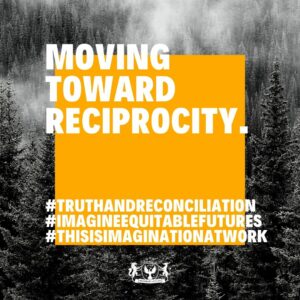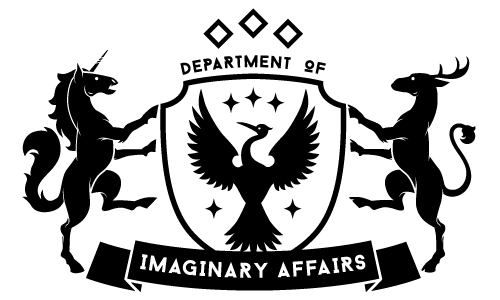 As September 30th approached, I was certain that it was important to me and to our team that we spend time investing in reflecting on our relationship with Indigenous people, communities, cultures – past, present, and futures.
As September 30th approached, I was certain that it was important to me and to our team that we spend time investing in reflecting on our relationship with Indigenous people, communities, cultures – past, present, and futures.
It is confusing and frustrating living in a country where government leadership can’t agree on the importance of truth and reconciliation. Even though Canada announced that September 30th, 2021 would be the first National Truth and Reconciliation Day, Ontario is not recognizing it. Currently, our team lives and operates out of Ontario and so I knew it was my job to figure out what we could do to honour the day that reflected where we are at in our reconciliation journeys and what more we can do.
We are doing a combination of individual and organizational reflecting, thinking, and acting that fits where we are at now. This is an ongoing commitment and one that requires an investment of time and effort. Our goal is to be in solidarity with Indigenous people and communities, and as non-Indigenous people, we are constantly learning and shifting our approaches to decolonize our practices.
Too often, we have seen organizations (and especially leaders) within the nonprofit sector saying one thing but not really following up with true action. This is frustrating and performative and we endeavour not to replicate this practice. We aim to be honest and transparent about what we know and don’t know, where we are stuck and where we are shifting.
About 2 years ago, I started sharing my personal reconciliation journey to accompany my land acknowledgments at the beginning of workshops. This is a decolonization practice that I observed another facilitator do once and it really stuck with me as a powerful way to make decolonization my responsibility and not the responsibility of others.
When it comes to reconciliation, my approach is to have a beginner’s mindset. I know I don’t know enough. I probably never will. Despite being a second-generation Chinese-Canadian, being born and raised on the stolen land we currently call Canada, I didn’t really come to think of myself as responsible for reconciliation until my mid-twenties.
As a child of immigrants, I used to think that I (and my family) weren’t here when colonization happened (as if it was something that happened long ago). I didn’t think land acknowledgments applied to me. I didn’t understand how much I had (and continue to) benefit from colonization.
This was just the beginning of this work for me. Since then I continue to find ways to listen to and learn from Indigenous people in multiple ways and embedded Indigenous ways of knowing and doing into my practice of imagining equitable futures.
Over the last few weeks, as I mentally wrote this blog in my head, there were a few things that stuck with me as practices that I need to do regularly, and not only around September 30th. I am sharing this journey as an artifact to myself and to the organization of where we are at now, this is not intended to be a roadmap or best practices in any shape or form.
We are currently working on a project called A Tale of Two Parks and the core storytelling question is, “What might parks look like if they are safe for everyone?”. This question has prompted several conversations within our team about who is safe and unsafe within parks, especially when thinking about Black, Indigenous, and People of Colour.
During a team meeting on September 14, 2021, our team was discussing a reflection question: “If you were in charge, what would you do to make parks safer?”
Chloe responded with this spark:
I think for me, if I was in charge, one thing that I would do is I would have like, someone there and if not someone there like, more like plaques and more like, knowledge and information on like the people that originally inhabited the land, but not only like a Frou Frou, this is who is here, but also very transparent on like, what happened to them and why they’re no longer here. So I think it’d be really important for all parks to have a very real indigenous presence, and just to be like, “Hey, this is lovely, and we’re enjoying it together. But this is so much stolen land that a lot of people die for us to be able to be here.” So I think one part of making parks safer would just be being like honest about that.
This sparked an idea and these questions:
What might it look like if parks truly recognized and honoured the lives and land lost in order for public parks to exist?
How might we use design futures to provoke action on truth and reconciliation within parks in Toronto so that Indigenous presence, history, and futures are acknowledged and shared?
In mid-October, our team will be reflecting and generating artifacts of the future together in the park. We imagine that many individuals are looking for ways to push their own thinking beyond what we have been told as truth and to move towards reciprocity, but don’t know what that looks like.
There is still so much work to be done and none of it will be easy – that is not the goal here. Here are our first steps.
- Prioritize our decolonization practices
- Interrogate where we are upholding white supremacy
- Keep this dialogue ongoing
- Be accountable for our actions
- Move from reconciliation to reciprocity
- Embed First Peoples’ Learning Principles and Indigenous ways of knowing and doing into our work
- Share our identities and relationships with reconciliation
These are values, principles, and practices that we will be carrying into all of our future work and this will be the basis of our employment, our partnerships, our projects, and our strategic direction.
This work is going to take compassion, courage, and commitment, in the coming weeks we will continue to share our reflections on reconciliation and moving towards reciprocity.
